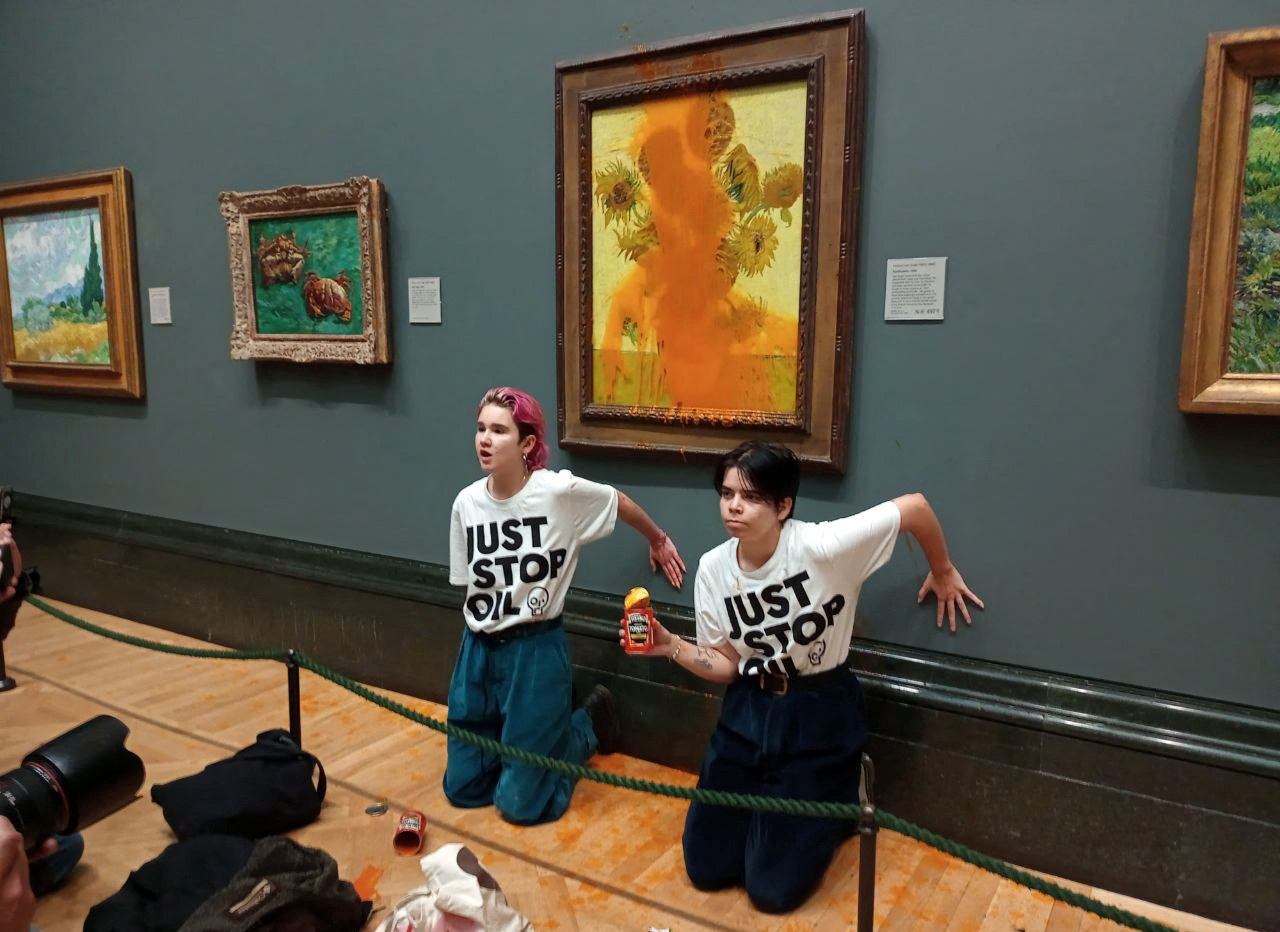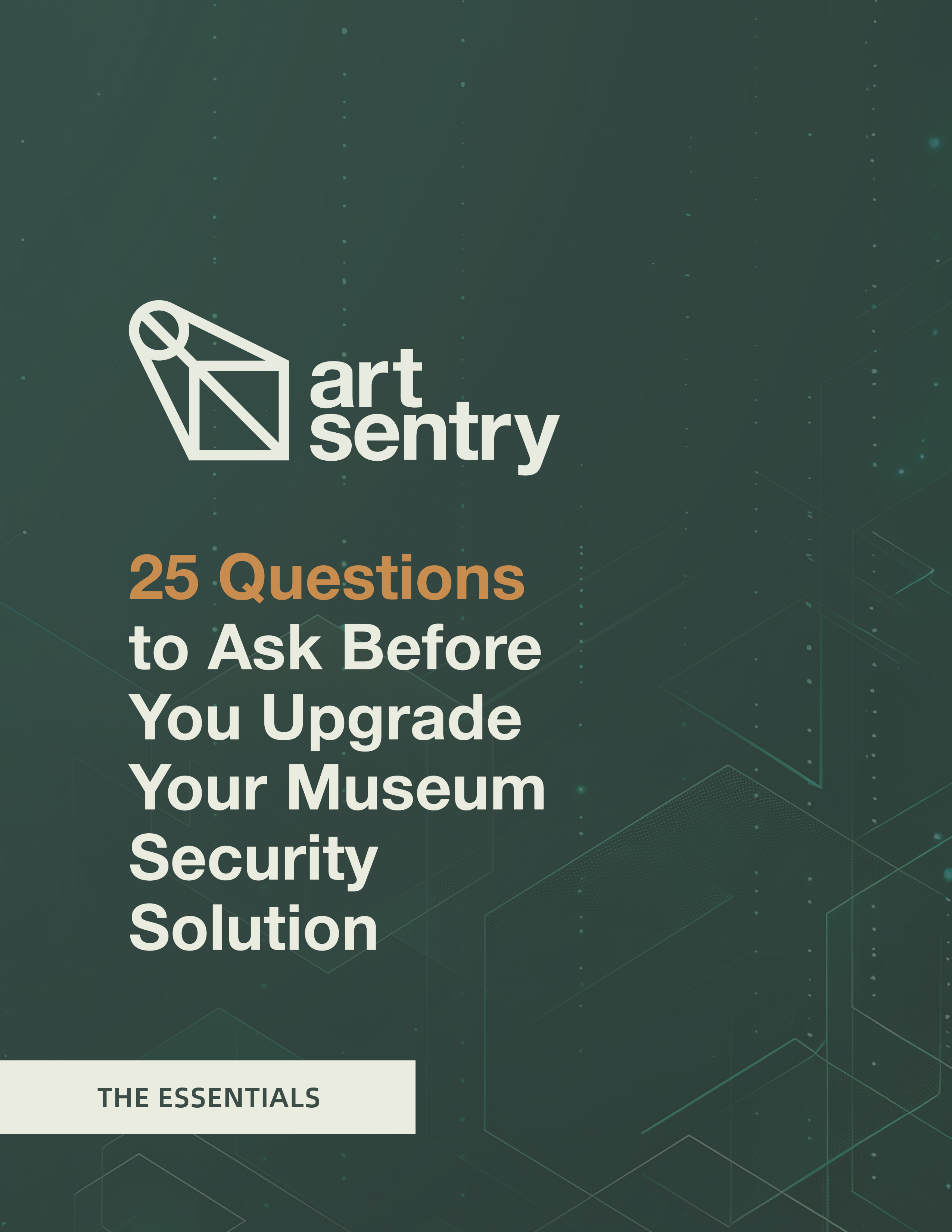By now, most of us have seen shocking images of art vandalism.
A pair or small group of environmental activists stage a protest in front of a high-profile painting, artifact, or historic monument. Some splash it with paint, soup, or cake. Many glue their hands to the front of the artwork directly or to the protective glass; others to the picture frame or adjacent wall. Then, the activists proclaim their message or demands such as ending the use of fossil fuels.
All museums, galleries, and cultural institutions that are custodians of collections or historic monuments should consider themselves a potential target for this type of vandalism by activists.
Why activists are vandalizing art
Groups like Just Stop Oil and Last Generation include vandalism of art and other cultural heritage in their larger strategy of committing “nonviolent (civil) disobedience.” Other forms of protest include blocking major roads, interrupting sporting events, and igniting baby carriages.
Throwing food on paintings or dousing the U.S. Constitution with red powder are meant to spur widespread media coverage. The motive is to mobilize public opinion for their particular issue.
But the result is thousands of dollars of damage to priceless works of art and other cultural heritage, hundreds of museum staff hours diverted to the clean-up, and growing public resentment against activists.
Not just isolated art vandalism incidents
These particular acts of vandalism against art in museums are substantial in number, with nearly 70 incidents since 2022. That total increases if you include historic monuments and heritage sites like Stonehenge, which was vandalized in 2024. This concentration of vandalism against artworks is unprecedented outside of wartime, and it is likely to continue.
Unfortunately, many museums and other cultural institutions are ill-prepared to deal with these situations. Likewise, some activists do not understand the adverse effects their nonviolent protests have on artworks, despite their claims to have “consulted with art experts” before staging their protests. Instead of art serving a role to heighten awareness and provoke thought around the climate crisis and other important issues, these acts render art as victims. Thankfully, there are some practical measures museums can take to secure collections against this emerging threat.
How to strengthen your security protocols
Know who you are dealing with
The easiest thing museums can do to prepare for, and possibly thwart, vandalism by activists happens to be the most cost effective. Security directors should dedicate time to research local activist groups operating in their area and their efforts to strike against collections.
To attract new members and get out their message, these groups must maintain social media, websites, and email list-servs, making information about their (planned) activities readily available. Attending recruitment meetings could also net details on what may be in store for the group.
Museum security should also make an effort to identify members of the groups posing the most risk to them. This can be done by scanning the internet and newspapers for spokespeople and others whose names are provided. Those names can be entered into the institution’s automated reservation system so that the museum can be alerted should they purchase tickets. Security will then have information about their potential visit and monitor them accordingly.
Keep in mind that protests are not just external threats; sometimes they come from within. Museums should maintain awareness for protest activity in large open spaces within the institution along with the main galleries. If a museum has a robust public programming calendar, security directors should dedicate time to knowing who the featured performers are and what sort of political activism might arise as a result of their event.
As with museum theft, the insider threat is the most prevalent and persistent danger collections face. Combining political activism with angry insiders puts museums at great risk. Security personnel must be prepared by engaging with staff and gaining the trust of employees who will, in turn, likely let security know if something is afoot.
Beef up physical security measures
There are several low-/no-cost physical measures institutions can implement to better secure their collections, starting with bag checks. Security should conduct bag checks at the museum main entrances. These checks are not time-consuming, as the guard is looking for very specific items like:
- Paint
- Banners
- Stack of leaflets
- Food containers
- Water bottles with colored liquid inside
- Small tubes of glue
Small bags can pass through with a mere glance. Backpacks should be directed to coat check or lockers.
Institutions should focus attention on the most noteworthy pieces in the collection and layer on additional security there. This does not include the pieces academics know to be famous or valuable, but what the media and the public would view as such. Activists are attacking art with the intent of getting attention. The pieces that they have chosen are not accidental. All have been highly recognizable artworks that are well-known in popular culture.
When trained guards are at a premium, it makes sense to invest in technological tools like detection systems. Camera-based motion detection and alarm systems, like Art Sentry’s, increase security in museums and galleries. They help prevent unwanted touches by creating an invisible protection zone around your most valuable artifacts and collection pieces. These systems can also raise the alarm (literally) if someone is spending a long time inside the protection zone, say, gluing their hand to the picture.
Watch people and the exits
Gallery guards should stay vigilant and take note of people acting unusually or in a coordinated manner. This includes a person positioning themself to film others, or people simultaneously putting down the small bags or other items they are carrying to remove their overgarments, which might conceal t-shirts with logos/messaging before attacking the art.
Museum security personnel should also pay close attention to ground-level emergency exits that are easily accessible from the exterior. Where bag searches and other precautions are in place, activist groups are known to send in one abettor who will let in the rest of the group through an emergency exit to bypass security procedures.
Finally, personnel in the museum control/operations room and Watch Desk guards should pay careful attention to the exterior of the building. Activists are known to do reconnaissance work before an event to include early morning visits to photograph cameras and other visible security measures. Capture images of such people and forward them to police.
Getting the community involved in protection efforts
Enhancing physical security measures is only one piece of the puzzle. Museums and other cultural institutions should also intensify their public outreach.
When an incident occurs should not be the first time you speak with first responders and “Friends of the Museum” groups about this issue. Security directors and museum leaders should engage early and often with these stakeholders, building rapport and reinforcing the role they play in protecting artwork from this type of vandalism. That role could involve quick response times or public awareness campaigns.
Museum visitors could also be encouraged to do more. Emerging studies are showing that artworks, and museums in general, are perceived by the public as inappropriate targets for nonviolent civil disobedience. Visitors’ willingness to intervene during an act of vandalism depends largely on their beliefs concerning damage to art and who is responsible for its protection.
The museum community should strive to instill an ethos that vandalism to art and cultural institutions is not socially unacceptable. They should create an environment in which all staff (not just security) and visitors are encouraged and empowered to step in when vandalism is occurring. For example, museums can encourage visitors to use publicly posted contact information to alert security teams if they witness behavior that places collections at risk or, for the bolder among us, call out the bad behavior in the moment.
Confronting activists when art vandalism is taking place is one option, but a more productive approach may be to create direct dialogue with activist groups when possible. The goal is to promote and support advocacy efforts that focus on constructive dialogue and peaceful demonstrations, rather than actions that risk damaging art and other cultural property. Of course, dialogue requires activist groups and museums being willing to come together – admittedly no easy feat.
Prioritize preparation now
The growing threat of vandalism by activists should be a top concern of all museums and other cultural institutions that care for collections of art, antiquities, and other cultural heritage. Prioritizing this threat and taking meaningful steps to prepare for and respond to a vandalism incident will help avoid costly repairs and closures. Activating key stakeholders and the public to push back against this tactic could also put activist groups “on notice” that museum visitors are watching and not afraid to intervene.
Seeking the advice of outside consultants to guide you through this process may also be helpful. Argus Cultural Property Consultants has experts on staff with decades of experience in museum security and crimes against art. They bring a holistic and tailored approach to protection that is unmatched in the industry.
Argus Cultural Property Consultants is a full-service firm specializing in the protection and preservation of art, antiquities, and other cultural property. It serves museums and other cultural institutions, along with residential, corporate, and government clients globally. The firm’s robust team has over 230 years combined experience in the law enforcement, government, security, and academic sectors. Argus CPC offers a broad range of cultural heritage protection products and services including security risk assessments, provenance verification, and training programs.
For your free consultation and to learn more, contact Catherine P. Foster ([email protected], +1 202-417-7282) or visit: www.arguscpc.com.


